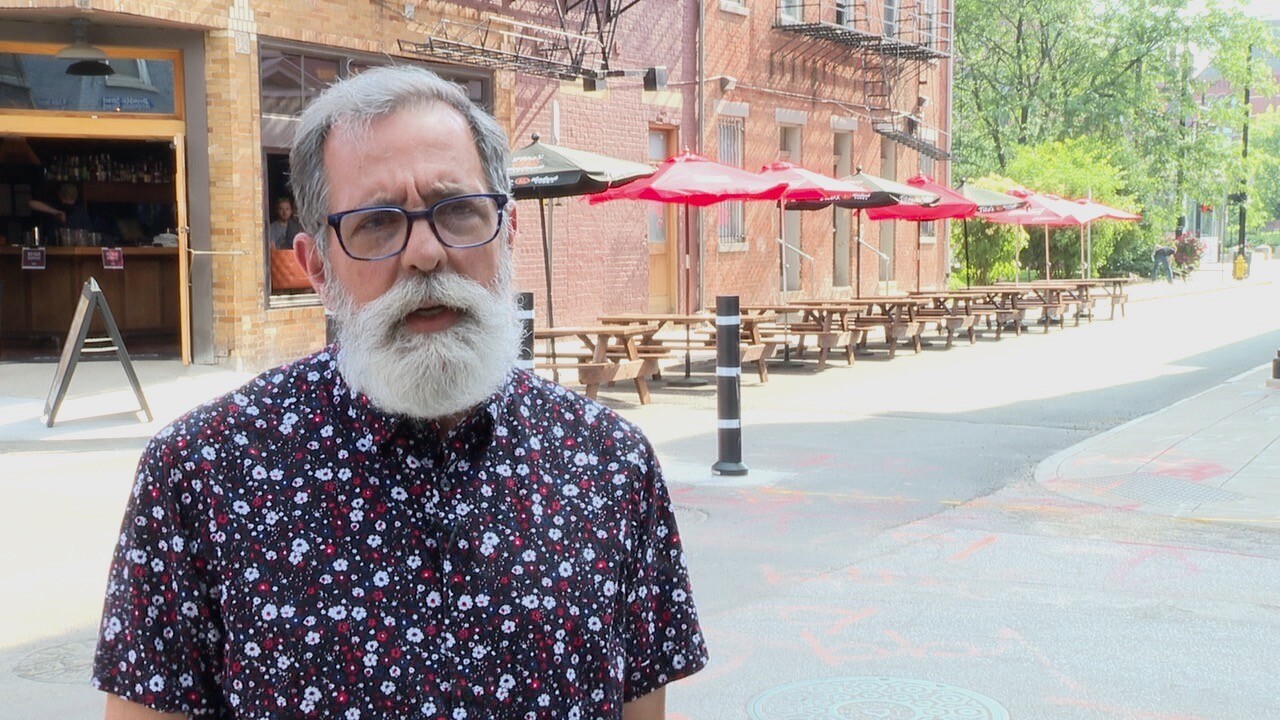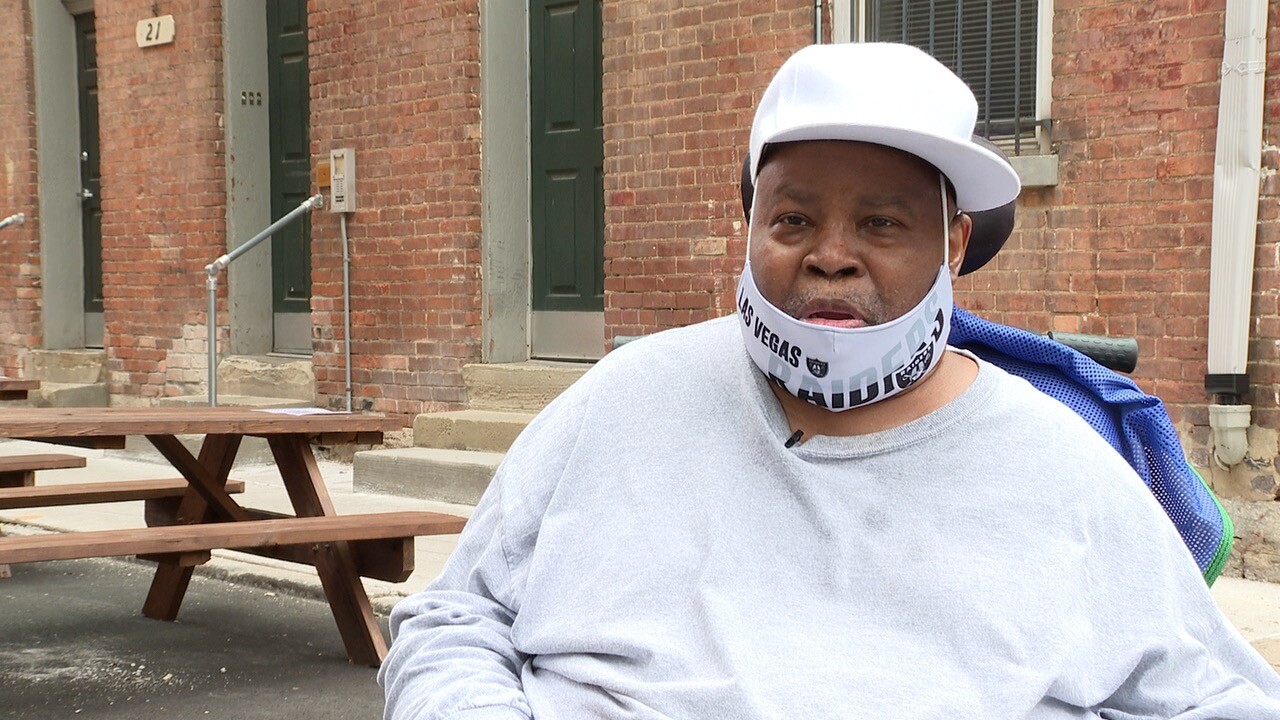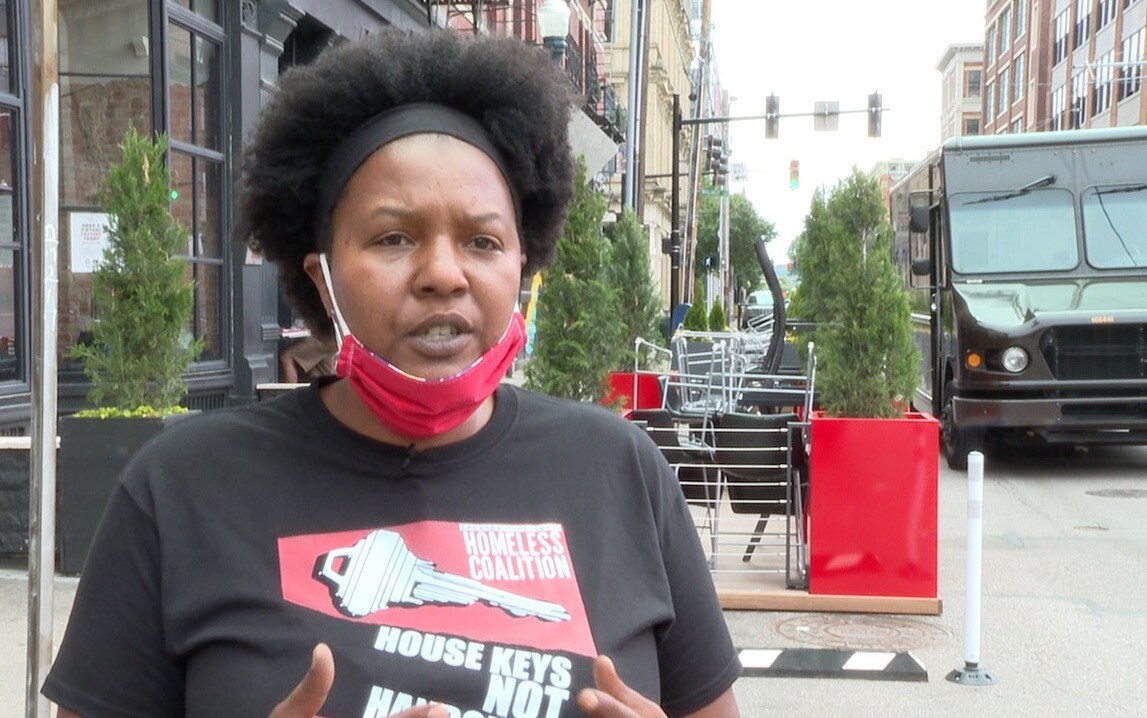CINCINNATI — As communities in our area and around the world found ways to create a new normal while COVID-19 ground our lives to a halt, one solution is sticking around: streateries.
And while many people -- from those in city government to restaurant workers to patrons -- are loving the way these outdoor dining spaces are transforming the community, others aren't so sure the changes are good for everyone.
Charlene Kelow-Coleman is a caretaker for her ex-husband, Bobby, who uses a wheelchair. She said she has struggled every day for the past year to find spots to park her car at Republic Street and 14th Street, where her ex-husband's apartment is located.
Outdoor dining spaces, combined with reserved parking and an inability to leave her ex-husband upstairs to refill her parking meter, have led to hundreds of dollars in parking tickets over the last year.
“I didn't like it when it was temporary,” she said. But when she learned through the local news last December that the city was going to make outdoor dining a permanent feature, she was furious.
Betty Kelow is Kelow-Coleman’s sister-in-law. She is also a lifetime Over-the-Rhine resident and a home health aide working at Republic and Race streets and has the same problem.
“It’s like I'm working to pay tickets," Kelow said. "It's not fair. It's not right.”

Kelow laments the fact that she drives to this pocket of Over-the-Rhine every day to serve her clients, only to struggle to find a reliable place to park her car and easily pay for her spot. Kelow says she knows the meter man who patrols her area by name, because she works in the area so much, but still can’t catch a break.
While many people laud a creative new way to bring more patrons to restaurants in Over-the-Rhine and Downtown, several residents, service workers and even some business owners said the changes have brought a long list of issues to their doorsteps. It's a story of gentrification happening in real time, and as is always the case with such changes, feelings in the community are mixed.
Community members criticize city government for not informing them in advance of its plans to institute an outdoor dining program, and for excluding them from the design and execution process. They also complain that the streateries have been lowering their quality of life and productivity inside their homes and businesses. Some vulnerable residents are feeling the neighborhood changes hurting their pockets, too.
Brian Harsh, a teacher approaching retirement, moved into his condo on 14th Street at the end of April. He transitioned into his new home just a week before his street was closed off to install outdoor dining for Low Spark and Zula, the bar and restaurant, respectively, situated on either side of his block. The homeowner said the diners are so noisy that it feels like they’re eating and drinking in his living room. He is considering soundproofing his windows.
“It's really annoying," he said. "And I'm not mad at the bar owners. I know they're trying to [make] do and create revenue after this horrible pandemic that we've had for a year. I'm mad at the city for not letting me know that this was going to happen at all. It wasn't disclosed to me.”
Harsh said he called the city to inquire about why the street was closed off before he moved in. He said he was told that the area was undergoing temporary street work, and would eventually be reopened in the upcoming days. It appears that his new neighbors did not know about the permanent changes to come, either.
Harsh shares Kelow and Kelow-Coleman’s grievances in the lack of street parking, as there are now dining tables and chairs in front of his building’s entrance, where he briefly used to be able to park his car. He now takes advantage of residential parking offered inside of the Washington Park garage nearby. But he noted it is still a hassle bringing groceries into his home. Plus, he said, if he hadn’t coincidentally moved into his home for the window of time when 14th Street was still open, he would not have been able to get his moving truck onto the street and his belongings into his condo.
But there is a larger accessibility issue that he and several other community members raise.
“My mother-in-law has a walker," Harsh said. "So we typically do not drive very far where she has to walk far.”
Before his street was closed off, Harsh used to be able to drop her off directly in front of his door. Now, the closest spot to his home where he can drop her off is at the corner of the block.
“So now she has to haul it down the street to get in the building. And what's going to happen to me in 10 years if I break a hip?” Harsh, 61 asked. “How am I going to get in my building? I can't — at least not conveniently.”

Bobby Kelow lives in a fourth-floor unit on Republic Street. He said that he used to move through Over-the-Rhine in his electric wheelchair with relative efficiency. He and his relatives had identified particular streets and routes he could move through to get to certain locations like Findlay Market and other attractions in the area.
“I used to ride the sidewalks, boom, boom, boom,” Bobby Kelow said.
But street closures have complicated his ability to move around, and the increasingly crowded sidewalks filled with diners and restaurant workers exacerbate the issue. All of the activity surrounding his building makes him feel trapped inside of his unit, despite once being able to ride around and socialize with family and friends in front of his building’s entrance.
Key Beck, a member of the Over-the-Rhine Community Council and a candidate for City Council, noted that they have seen people with bikes, strollers and small children accompanying them struggle on the sidewalk, as well.
On one occasion, Beck observed an altercation between a resident on their stoop and nearby diners, resulting in the police being called. On another occasion, they saw a car crash unfold on Vine Street because people were illegally parked on either side of a streatery.
A number of the residents also pointed to an incident in which firefighters faced complications while putting out a fire in a residential building on 14th Street between Race and Republic. They say they worry about paramedics and firefighters being able to reach them in the event of an emergency after having to bypass the street dining.
“Who's going to be accountable for, if those few seconds cost somebody their life?” asked Charlene Kelow-Coleman. “You know, is it worth these people eating, getting a meal outside where they want to be at versus somebody’s life? It just doesn't seem right.”
Some of the community members expressed that they see the value of the streateries. However, they argue that the way the city has managed the project exemplifies its track record in prioritizing the interests of OTR’s entertainment businesses over those of residents, workers and service organizations. The community members say that engaging them in the effort would have made the streateries more practical, inclusive and accommodating to their needs.

“While we appreciate having people come to the community, we just want to be respected as residents,” said Beck. “Regardless of what people call it, a tourist destination and entertainment destination, this is first and foremost a residential neighborhood.”
“If we're not really thoughtful about how we integrate the commercial and residential aspects of this neighborhood, we may lose some of the very important diversity and charm that creates the very place that people want to visit,” said Margy Waller, a member of the board of trustees and a chair of the quality of life committee on the Over-the-Rhine Community Council.
Community members argue that the lack of inclusion in outdoor dining has socioeconomic implications, as well. Critics argue that the streateries privatize public space and also alienate longtime Black and low-income/working-class residents who otherwise might not have the means to dine at OTR establishments with higher price points.
Betty Kelow charges the city with jumping on an idea that sounded good without considering how these amenities would make certain vulnerable people suffer further.
“I love the diversity. Don't get me wrong. I love the diversity,” Kelow said, referring to the more affluent customers who are being attracted into the area. “But it wasn't a well-thought-out plan, I don't believe. It don't involve most Afro-American people, low-income people. It don't involve us. That's why we don't, you know, you don't see us, too many of us, out here.”
Mona Jenkins, the director of development and operations at the Greater Cincinnati Homeless Coalition, senses an insidious, underlying desire from developers and the city to erase certain vulnerable people from the area as well.
“This has been literally one of the worst things that has happened. We are slowly getting pinched out. There is no consideration for us as far as a business. And I wonder what's happening to some of the other small businesses that are along Vine Street.
“It's a slow attempt to gentrify particular residents within the space out, particularly Black folks and low-income folks. And so it's now targeting a whole different clientele... So now you don't want us living there, you don't want us parking there. Our enjoyment of life does not matter. You're catering more towards folks who are from the outside and coming in. So those who live here daily, they're not considered.”

There are now two outdoor dining spaces on either side of the Homeless Coalition’s office for Revel and Rhinehaus, two local bars. The Homeless Coalition cooperated with the installation of the streateries because they recognized the need to keep the businesses open to protect the jobs of the bars' workers.
However, Jenkins explained that her team had not been informed by the city that the streateries were coming, and instead was informed by one of the bars participating in the outdoor dining program.
Jenkins further explained that the Coalition's staff and patrons have also been irritated by the fact that they have struggled to preserve their organization’s handicap parking. Jenkins said this has been caused by logistical issues made by the city placing incorrect signage in front of their building despite what was agreed upon in negotiations prior to the streateries being installed.
Their parking issue has also been made worse by other locals ignoring their reserved parking signs, as well as the fact that their parking options have also dramatically been reduced from the presence of the streateries and the implementation of reserved residential parking. Jenkins validates the city’s goals in making the area more walkable through installing features like outdoor dining. However, she argues that optimizing the transportation system further would contribute to that goal, considering that Cincinnati is still a place where people have to rely on vehicles.
“It's important that we have consideration for our folks that we serve,” Jenkins said. “And basically, the city just didn't have consideration for that. Never contacted us. We should have been a part of the process to say, ‘Hey, are these streateries going to work on this particular street? But we were left out of that conversation.”
Last month, Mayor John Cranley led a press conference recognizing the first phase of streateries to be permanently installed in OTR. WCPO asked the mayor for a response to the noise complaints made by residents who were unaware of the streateries plan, as well as criticisms of the area becoming increasingly inaccessible.
The mayor replied saying that outdoor dining’s changes to the area connect with its urban culture, though he recognizes that not everyone appreciates that vision.
“All of these decisions went through the process of public hearings and City Council votes and that’s what the elected officials decided to do. And, obviously, I think if the City Council was wildly out of whack with the wishes of its constituents, there is an election in November where people can make that clear.”
However, board members of the Over-the-Rhine Community Council push back on this. They say the city ignored their objections, as well as their requests for City Council to table its vote on the project until the community was briefed and consulted on the city’s plans. Margy Waller said the city only informed the board of its plan to make outdoor dining permanent until hours after the mayor held his press conference on the subject back on Dec. 4.
She explained that normally, the planning department would conduct research to determine how to best execute the logistics of a project and who from the community should be involved. From there, the City Council moves to allocate funds for the effort. However, in this event, Waller said that the planning department process happened after plans were made and City Council voted in favor of the program.

WCPO followed up through multiple attempts with the mayor’s office requesting an interview to address residents’ various other frustrations brought on by the streateries detailed earlier. Chief of Staff Holly Stutz Smith responded with an emailed statement saying:
If our restaurants don't survive, it will forever change the fabric of our city. It will take all of our continued support to help them recover. The implementation of these permanent outdoor dining areas has already started to have a positive impact on the urban core. In addition to supporting local businesses, the streateries have added vibrancy in Downtown and OTR and provide important traffic-calming measures. I am excited for more of our residents to return to Downtown so they can experience the transformative impact of the streateries. We’ve spent years working toward [and] achieving growth and economic prosperity. COVID paused that momentum. We've made many sacrifices and deep cuts during the pandemic and [w]e are making huge investments to restore what was lost, secure our future and continue to grow.
3CDC, the developer overseeing the execution of the outdoor dining program, responded to our questions about the concerns voiced by community members through a statement, as well. The email from Joe Rudemiller, Vice President of Marketing and Communications, reads:
There were multiple opportunities to provide feedback on the streateries through the public process, which included City Council’s Budget & Finance Committee (12/14/20) and the full City Council meeting (12/16/20), as well as a public engagement session on the partial street closures (1/19/21) and the Planning Commission (2/19/21).
With respect to parking, in the last two years, 3CDC has added the 560-space Court & Walnut garage in the Kroger On the Rhine development, the 35-space Central & Walnut Lot, the 99-space 1400 Vine Lot, and the 584-space 4th & Race garage, creating a total of 1,278 new parking spaces in the urban core (694 of which are either in OTR or adjacent to OTR, as is the case with the Court & Walnut garage and Central & Walnut Lot). It's worth noting that the hourly rates for these lots and garages are all lower than rates for metered parking.
The streateries were created in a such a way that full access to the sidewalk is maintained, and they are level with the sidewalk to ensure they are accessible to people with limited mobility.
Waller pushed back on this statement as well, noting that the city and 3CDC were already cemented in their plans once they announced the project. She further described any input from the community that would have been offered at the various occasions Rudemiller referenced in his statement as "pointless," since those events happened after Mayor Cranley’s Dec. 4 press conference.
Going forward, community members urged city leadership to engage them more in the area's development projects. They called for greater consideration of different residents’ needs, especially those with disabilities, so that the neighborhood is accessible to all. Simply catering to those who are able-bodied is too problematic for Over-the-Rhine’s diverse population, they say. Consulting with people from different backgrounds who make up Over-the-Rhine and Downtown is what they believe will safeguard against conflicts like the ones community members are currently facing.
“After a year or two, it is perfectly a good option to check: what are the pros and cons of this?” Beck proposed. “Did this work? Do we need to change it? Should we eliminate it?”
If nothing else, Harsh wishes for the mayor to see things from the residents’ perspective.
“I would like to know if he would like 54 people sitting in his front yard drinking beers all night, and how that would make him feel.”
Monique John covers gentrification for WCPO 9. She is part of our Report For America donor-supported journalism program. Read more about RFA here.
If there are stories about gentrification in the Greater Cincinnati area that you think we should cover, let us know. Send us your tips at moveupcincinnati@wcpo.com.



